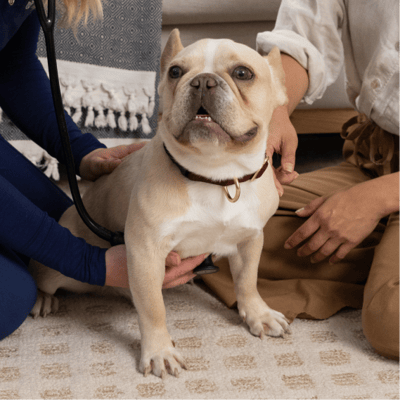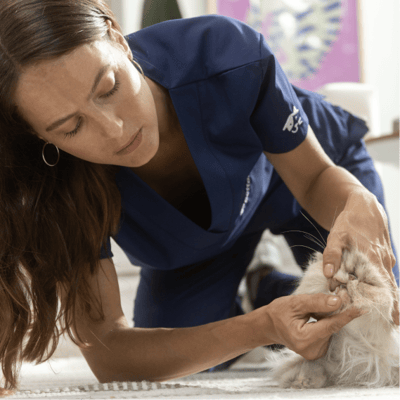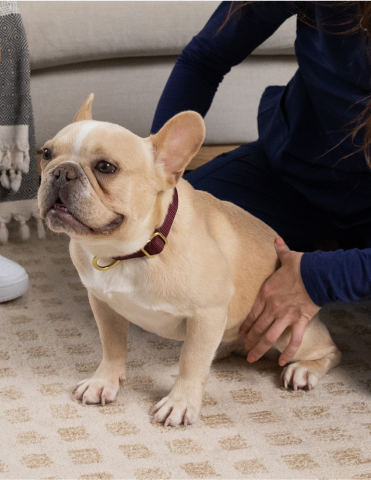
Why BetterVet?
Our mobile veterinarians examine pets in their favorite spot - a comfy couch, a cozy pet bed, or even your lap! See how we work to keep pets relaxed and happy at home.
As part of your pet’s in-home Wellness Exam, your veterinarian will perform an orthopedic health assessment as part of your cat or dog’s head-to-tail examination.
Note: Orthopedic consultations are included in the cost of a comprehensive physical exam. To book an appointment, choose Wellness Exam for the service type, and specify the reason for your appointment.

During an in-home Wellness Exam, your veterinarian will be able to observe your pet in their home environment, allowing them to assess your pet’s orthopedic functioning accurately.
Avoid the stressors of transporting orthopedic pets to the clinic. Our Fear Free® certified veterinary teams have extensive training in keeping pets calm and relaxed during their examinations.
Our in-home veterinary model builds in enough time for our veterinary teams to spend with each pet and their parents(s) and to create an individualized treatment plan.
In-home veterinary care is less stressful for pets and more convenient for pet parents. Save the time you would have spent commuting to and from clinic appointments, and we'll come to you!
Our in-home exams include a comprehensive assessment of your pet’s orthopedic functioning. We will also recommend additional tests or a referral to a veterinary orthopedic specialist (for an additional cost) when necessary.
As part of our commitment to treating your whole pet, your veterinarian will observe your cat or dog, thoroughly examine their musculoskeletal system, and make recommendations when necessary.

Evaluation of your pet’s orthopedic health will begin with a review of your pet’s history and a thorough checkup of all the systems of the body.

A general orthopedic assessment includes specific tests that can be carried out during a home visit. These include an evaluation of your pet’s muscles, joints, ligaments, and bones. We may recommend additional tests, x-rays, or a referral to a veterinary orthopedic specialist (for an additional cost).

Based on your pet’s examination, our veterinarians will work with you to make the best plan for your pet, which may include medication, pain management, and other recommendations to support your pet’s quality of life.

Before the end of your in-home visit, your veterinary team will provide any necessary prescriptions and referrals, and schedule follow-up appointments.

Dr. Kiefer and Erin were a great team. Arrived exactly on time per notification - no time wasted in a waiting room. Rolo the dog had his vaccines and a thorough exam of his limp and other hip arthritis, leading to an x-ray and some great recommendations of medications and other therapies. Minot the cat had a biopsy on a lump - he’s a fighter and it wouldn’t have gone well at an animal hospital, but at home he was matter-of-fact about it. Great experience!
During an in-home visit, your expert veterinary team will observe your pet and perform a number of common orthopedic tests, such as:
Your veterinarian will observe your pet’s gait and movements in the relaxed environment of home and look for signs of limping or unusual movements.
Our team will evaluate your pet’s muscles, joints, ligaments, and bones. They will also assess your pet’s range of motion and joint mobility, an important step in understanding your pet’s orthopedic health.
During your pet’s in-home orthopedic evaluation, your veterinarian will assess the flexibility of their neck and limbs. They will also look for any signs of pain, discomfort, or swelling of the back, neck, and limbs.
Our veterinarians will make appropriate recommendations, including pain management, based on our examination. There are some especially promising new medications for pet arthritis treatment and chronic orthopedic conditions.
As stated above, if your veterinary team feels that an outside resource is necessary to help with your pet’s treatment plan, they will make the appropriate referral to a board-certified veterinary orthopedic specialist.
A veterinary orthopedic evaluation takes place during a Pet Wellness Exam, which typically lasts between 30-45 minutes.
Be prepared to discuss your pet’s medical and orthopedic history, any symptoms, and any medication your pet is currently taking. If you have noticed a particular issue with your pet’s movement or mobility, a video demonstrating the behavior would also be helpful.
We have flexible appointment times and have same-day and next-day availability in many locations. Remember to book a Pet Wellness Exam, which includes a comprehensive orthopedic assessment.
Tendon and ligament injuries, as well as other mobility issues, are common in pets. Your veterinary team will work with you to make the best treatment plan for your pet, which may include recommendations for medication, diet or exercise changes, and referrals to specialists.
Before your veterinary team concludes your in-home visit, they will provide you with all necessary prescriptions and referrals and make sure that you understand any post-visit care instructions.
Board-certified veterinary orthopedic specialists have undergone extensive education and training to achieve expertise in the diagnosis and treatment of orthopedic conditions in pets.
There are a few common orthopedic issues in dogs such as hip dysplasia, cruciate ligament tears, and osteoarthritis. Hip dysplasia is a condition where a dog’s hip joints do not develop normally, causing them to grind against one another leading to discomfort and mobility changes. Cruciate ligament tears affect the knees and usually occur secondary to trauma. This is a painful condition and a referral to a veterinary orthopedic specialist is often recommended for treatment. Osteoarthritis typically affects older pets and pain management is initiated to provide comfort and improve mobility.
Osteoarthritis is one of the most common orthopedic issues seen in cats. Osteoarthritis is often diagnosed based on our physical exam and your cat’s history. There are certain treatments we can recommend to manage your cat’s symptoms, such as pain medication and changes to your cat’s diet or routine.

Skip the traffic by booking a mobile vet visit with one of our trusted veterinarians. We bring full-service vet care to you!